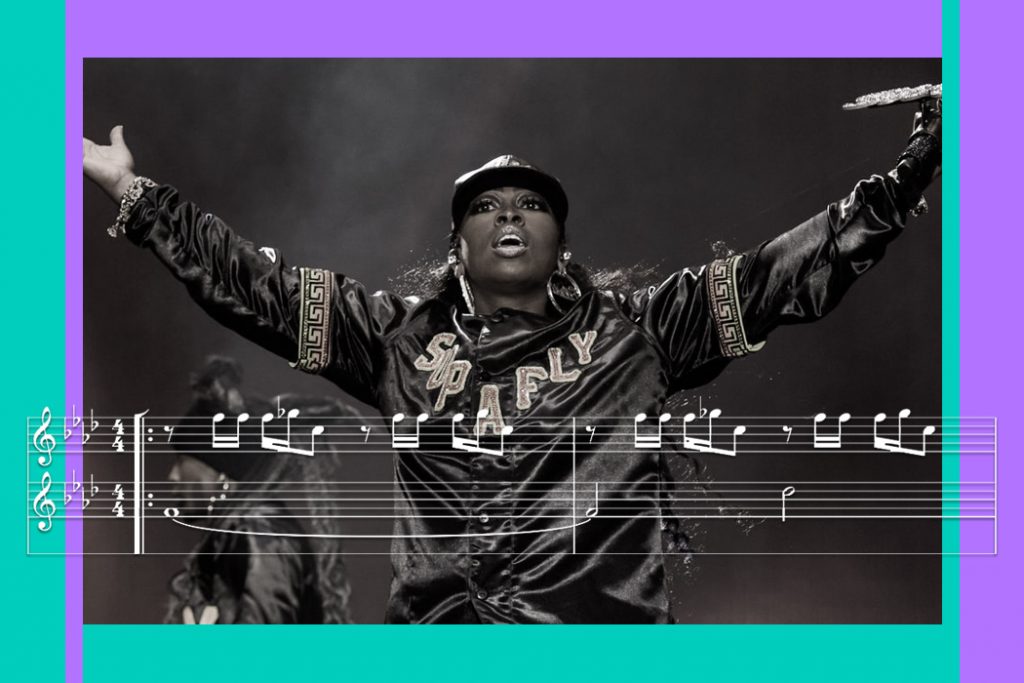+ Bridge the worlds of theory, improvisation, and jazzy hip-hop, and improve your piano chops with Grammy-winner Kiefer in his course, Kiefer: Keys, Chords, & Beats.
Missy Elliott’s “Get Ur Freak On” and the Phrygian scale
If you want to get a little freaky with your music, a good way to start is by picking some freaky intervals, like those found in the Phrygian Mode. Rarely used in Western music, but common to the rest of the world, the Phrygian scale is a perfect way to add an unexpected, worldly influence to a decidedly American genre like hip-hop.
The Phrygian scale is related to the natural minor scale, but with a flattened second, or a flat-two. This creates a minor second interval between the first and second notes of the scale. When played starting on E, the scale conveniently corresponds to all of the white keys on the keyboard (E, F, G, A, B, C, D, and E).
In Missy Elliott’s 2001 hit “Get Ur Freak On,” produced by Elliott and her longtime beat production partner Timbaland, the unfamiliar quality of the mode is accentuated by the song’s aggressive lead line. This sampled tumbi sound is a sort of clavichord-esque, percussive anthem that relentlessly propels this dark beat forward. For more on how Elliott innovates both in her beat making and the syncopated style she uses to rap alongside her beats, check out this article.
And by the way, if you’re interested to learn more about how to harness the intersections between jazz, improvisation, and modern music like hip-hop in your own music, you’re going to love Soundfly’s newest course with jazz pianist and beat producer, Kiefer: Keys, Chords, & Beats.
But for now, let’s look at the weaved syncopated patterns created by the “Get Ur Freak On” beat in standard notation.
The tumbi pattern is three quick Fs, a G♭, and a C. It appears to repeat identically eight times, but there’s one subtle variation. On the seventh time through, the pattern lands on D♭ instead of C. That tiny asymmetry is enough to keep your ear slightly off balance and keenly interested, no matter how many times you hear it.
“Get Ur Freak On” is written in F Phrygian, which looks like this:

That G♭ is the note that gives Phrygian its distinct sound. Used often in the music of the Middle East and North Africa, the sounds of the Phrygian scale (especially the minor second) are also common in Spanish music, which is unsurprising, given the strong Moorish influence on the musical culture there. In fact, Spanish music often takes it a step further by having a minor second AND a major third, a variation referred to as Spanish Phrygian or altered Phrygian.
You can hear this sonic palette (and especially the minor second) at work in Paco de Lucia’s flamenco:
Phrygian and other modal scales featuring the flat-two scale degree are also common in South Asian music. Perhaps the single most defining hallmark of Bhangra music is this one-stringed tumbi we hear so prominently in “Get Ur Freak On,” and as seen in this repetitive use of the flat two below.
Combined with the other notes in this raucous riff, this mode contains some pretty dissonant intervals, both against the root note and against one another. However, the fourth and fifth degrees of the scale are both very consonant, giving the mode an element of balance and stability that brings it back to Earth.
Jam with “Get Ur Freak On”
If you haven’t fully wrapped your head around the Phrygian scale yet, that’s okay!
We suggest you use either the comfort of your DAW of choice, or the magical web-based aQWERTYon, from the NYU MusEDLab. Below is a MIDI file we made of the melody to “Get Ur Freak On,” set up in F Phrygian. And here’s the link to use aQWERTYon to play along with the track itself. (*Note: The aQWERTYon only works in Chrome for now.)
Download: “Get Ur Freak On” — Basic Verse Melody MIDI in F Phrygian
Let’s hear more Phrygian!
Here are a few really unique grooves written in Phrygian by students enrolled in our Theory for Producers: The White Keys and Minor Modes course!
DJ Neko Sensei
Lisa Reshkus
DMC Daitenshi
Challenge: Create a Phrygian Groove
Now it’s your turn! We challenge you to create a 4-bar groove using the Phrygian scale. If you want, you can make use of only the white keys from E to E (E, F, G, A, B, C, D, and E), which is the simplest way to explore the E Phrygian scale.

For an extra bonus, transpose the scale into a different key, using the same intervals (root note, half step, whole step, whole step, whole step, half step, whole step, whole step back to the root), and share it in the same way!
Note the intervals between the notes of the E Phrygian Scale:

Share your work in the comments below! We’d love to hear it.
Want to get all of Soundfly’s premium online courses for a low monthly cost?
Subscribe to get unlimited access to all of our course content, an invitation to join our members-only Slack community forum, exclusive perks from partner brands, and massive discounts on personalized mentor sessions for guided learning. Learn what you want, whenever you want, with total freedom.





